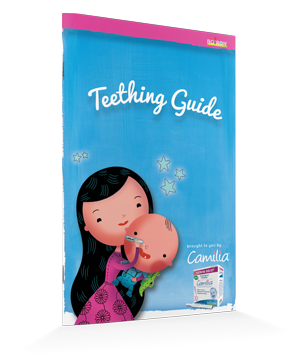So how do you know if your little one is teething? Most babies experience increased drooling and crankiness. Here are six signs of a teething baby from Parenting.com:
The need to gnaw
The pressure of an emerging tooth beneath the gums may be relieved by counterpressure, so teething babies often want to chomp on things. The chewing instinct may also be a response to the odd sensation that something’s going on in there.
Puffy gums
Before a new tooth erupts, it can cause a red, swollen, bruised-looking area on a baby’s gums. Sometimes the gum bulges with the emerging tooth, which you can see faintly beneath the skin (if you can convince your baby to open his mouth for long enough).

Excessive drooling
Increased spittle can herald a new tooth—– but it’s also a normal developmental stage of infancy, so don’t assume that drooling means teething. There’s no way to tell whether your baby’s saliva is the result of teething or not, though it may be if you also see signs of drooling.
Fussiness, especially at night
Tooth eruption—–when the tooth moves through the bone and gum—–tends to come in stages, with more activity at night than during the day, so your baby may be more irritable in the evening.
Ear pulling
While it can also be a sign of an ear infection, tugging can be a symptom of teething: The pain from the jaw gets transferred to the ear canal.
A change in eating habits
Babies who are eating solids may want to nurse or bottle-feed more because a spoon irritates their inflamed gums. Others may do the opposite, eating more than usual because the counterpressure feels good. And babies who are still on the bottle or breast may begin feeding eagerly but pull back because the activity of sucking puts uncomfortable pressure on the gums and ear canals.
Since some signs of teething may actually be signs of illness, please call your baby’s doctor if the above symptoms don’t ease after a few days or if they worsen.




